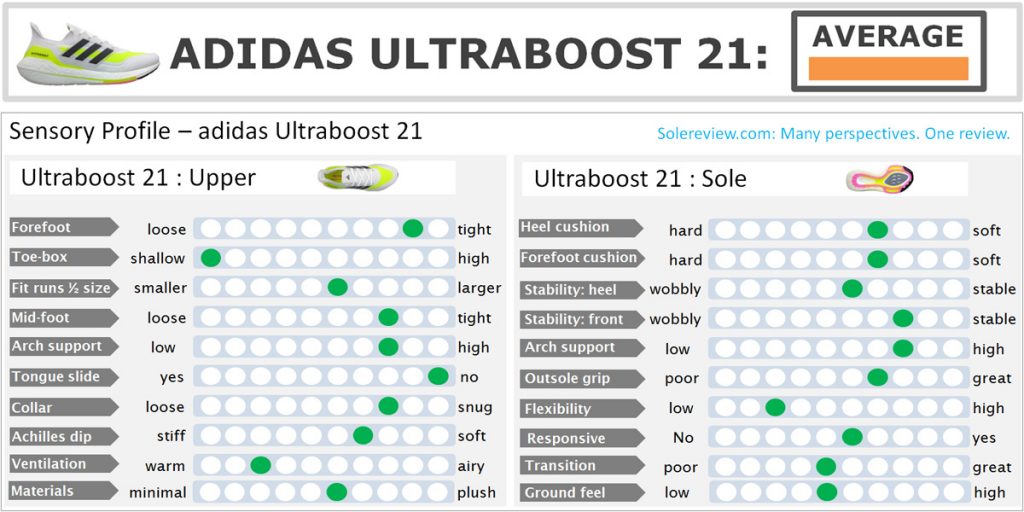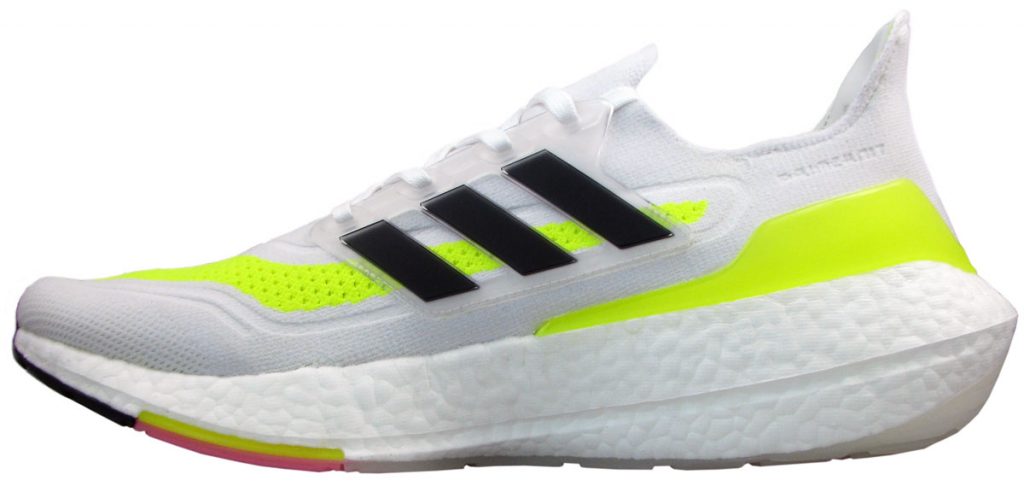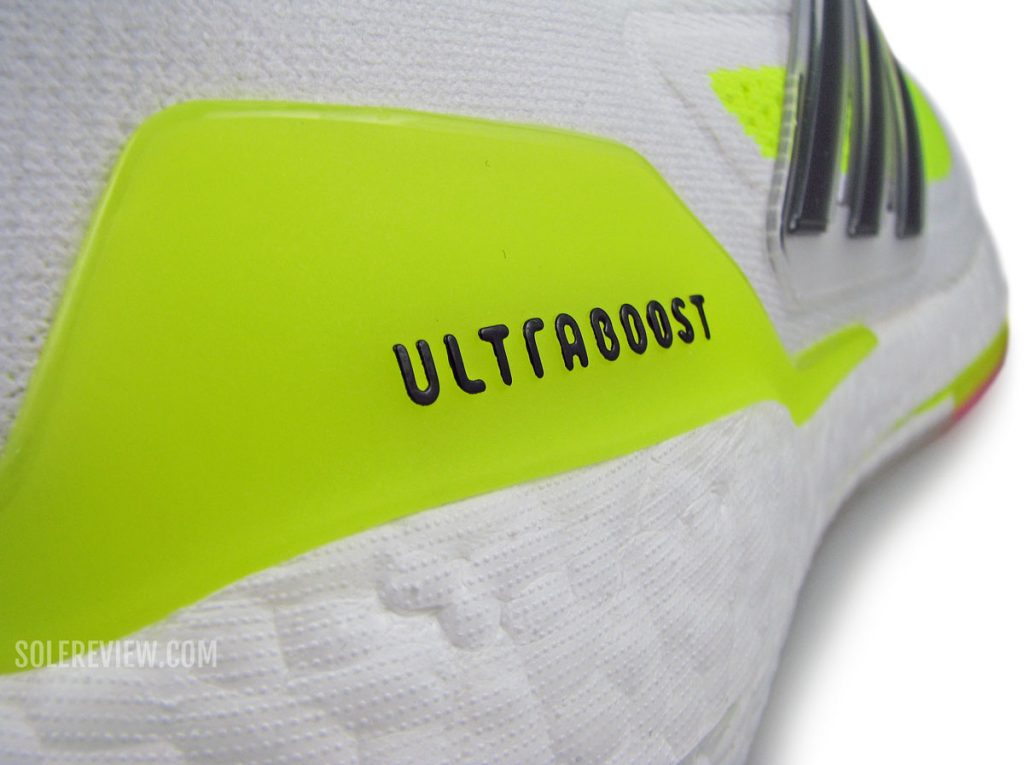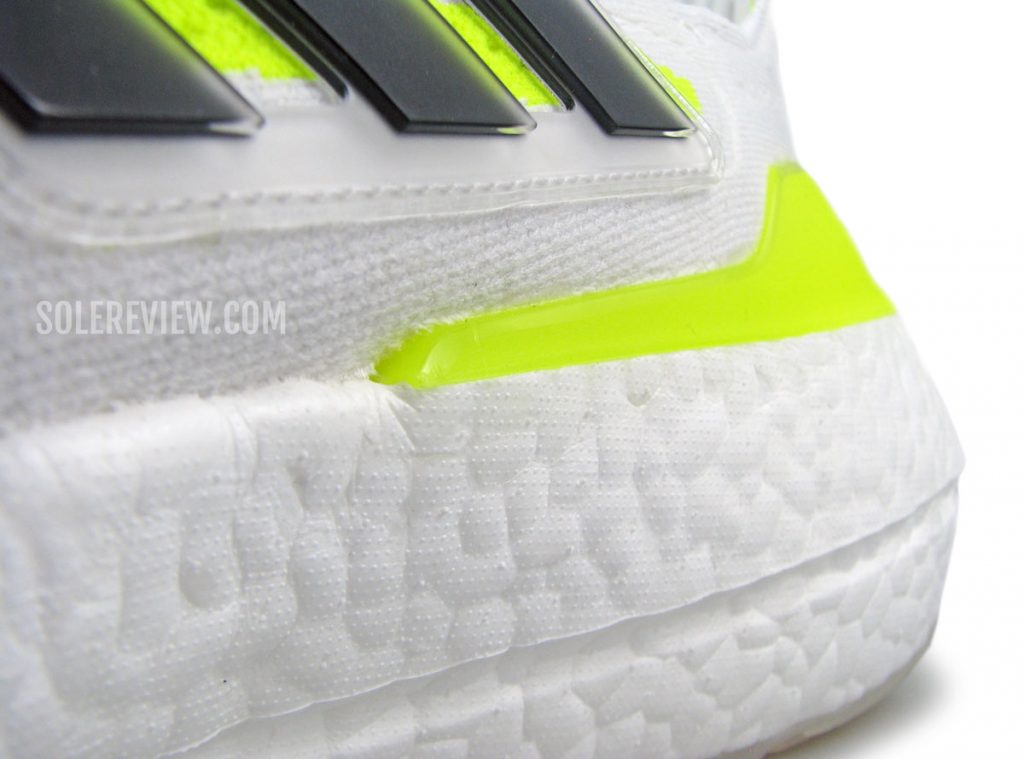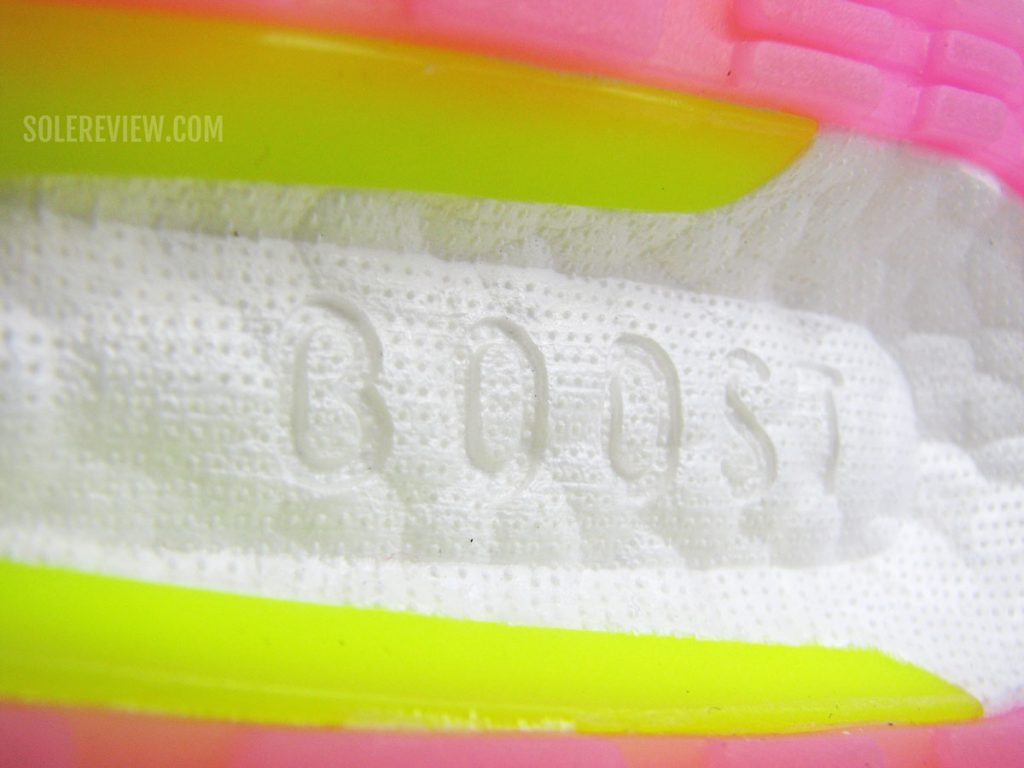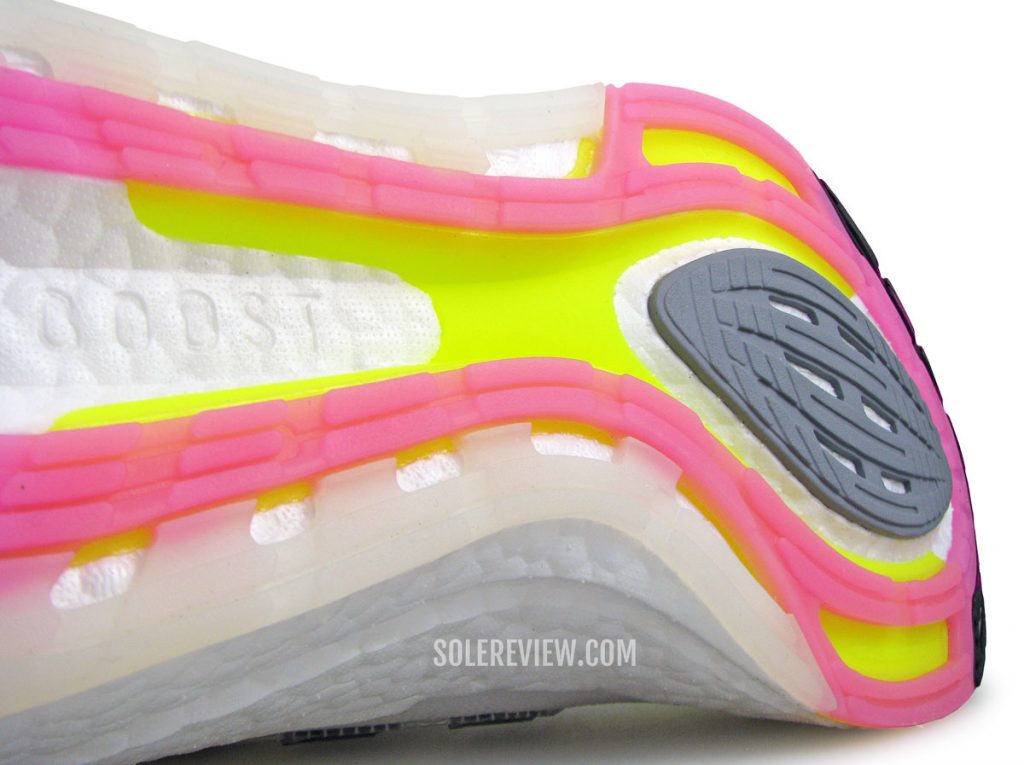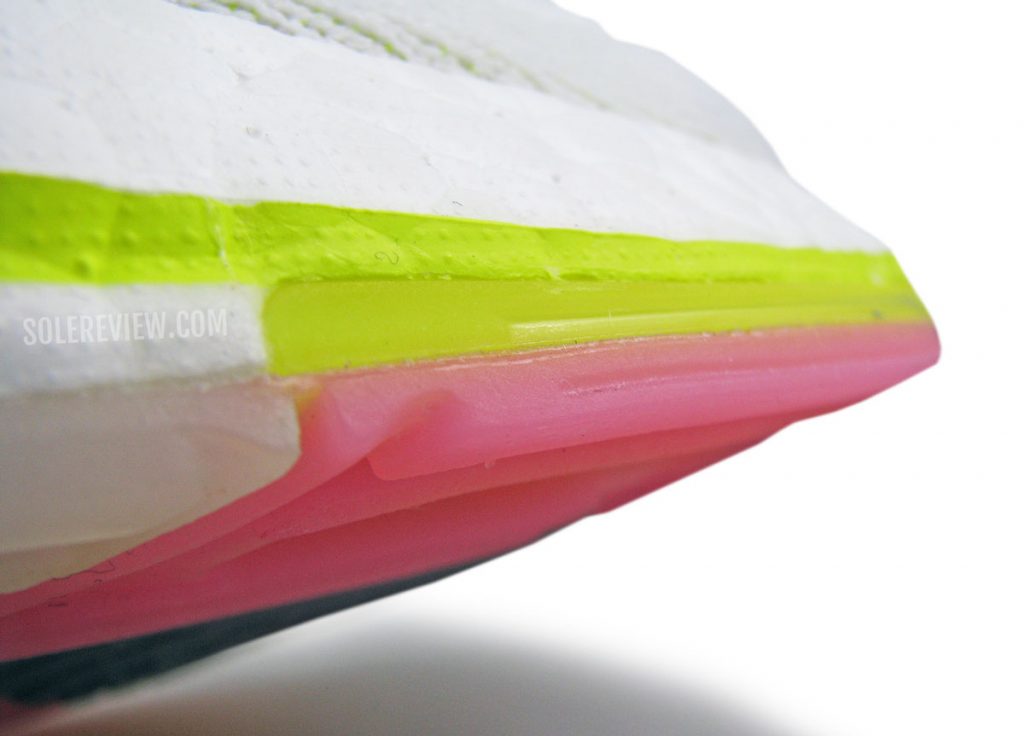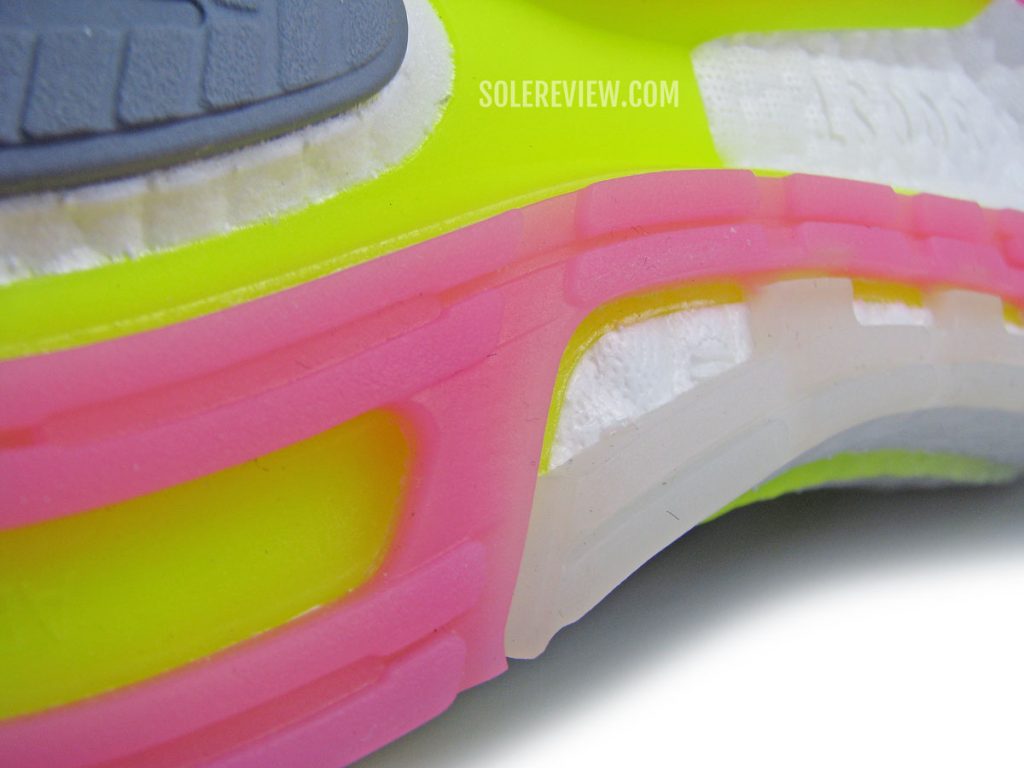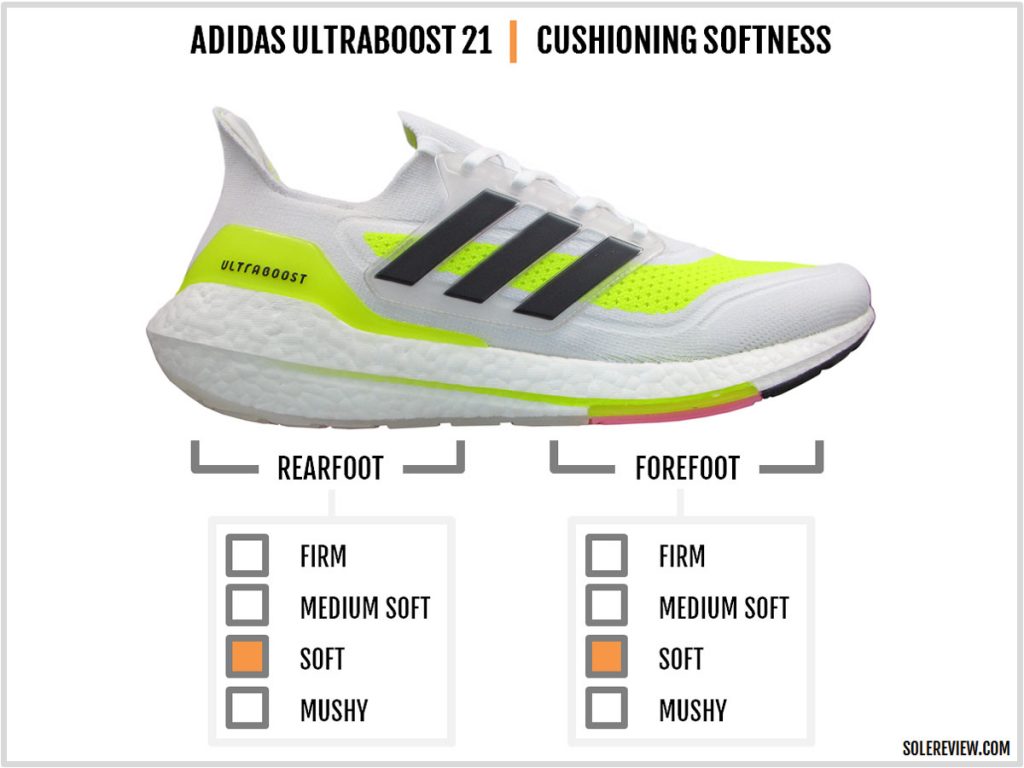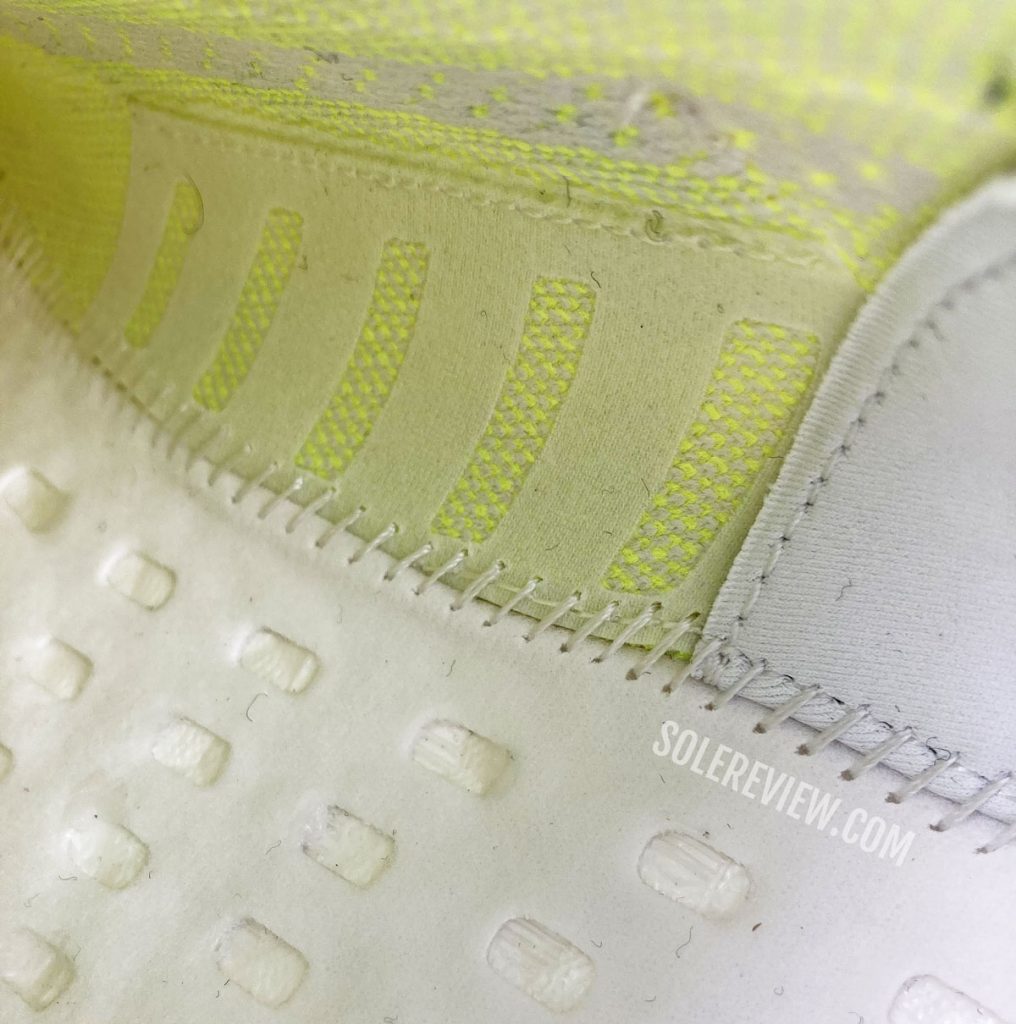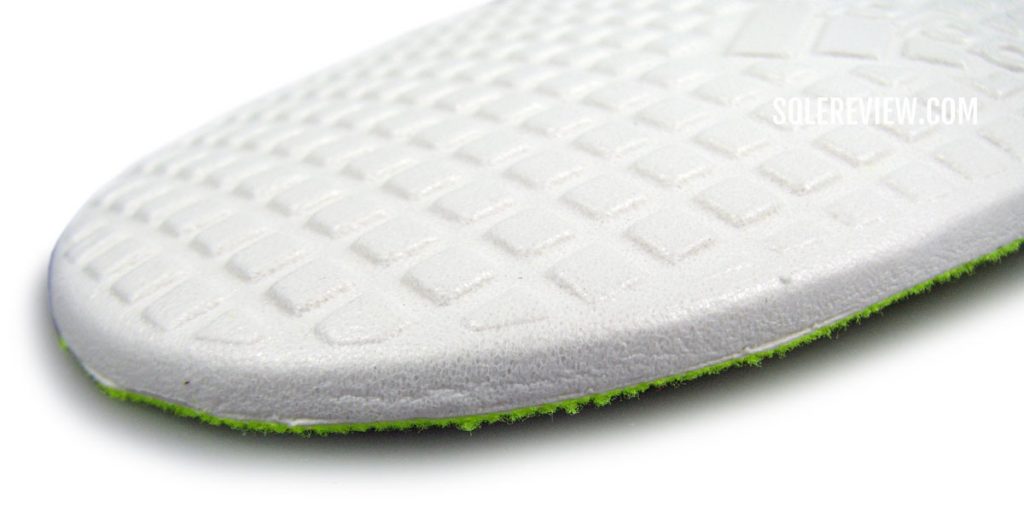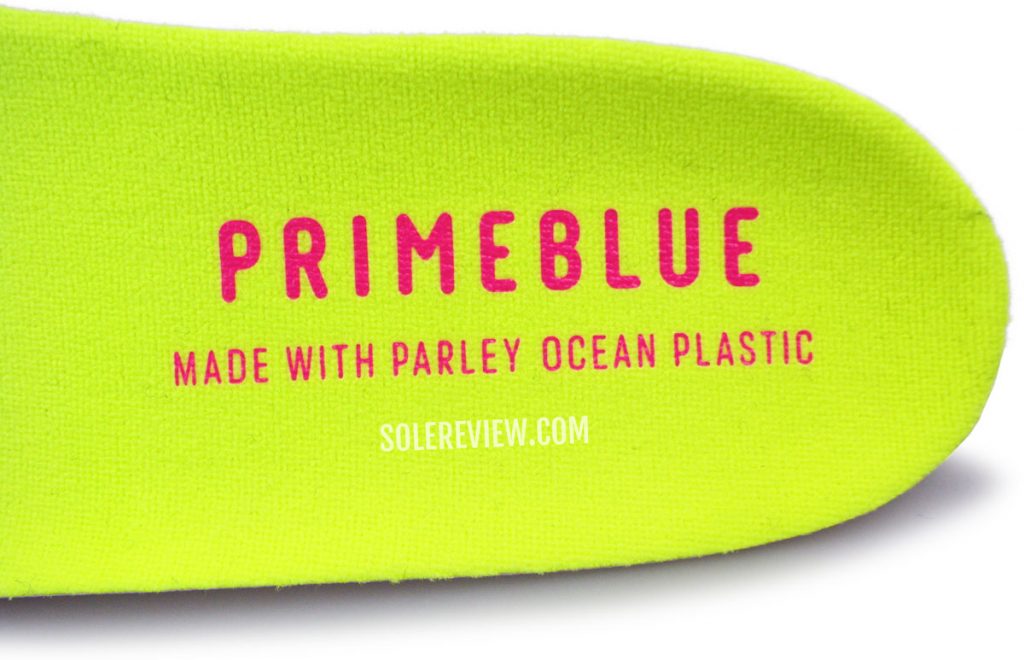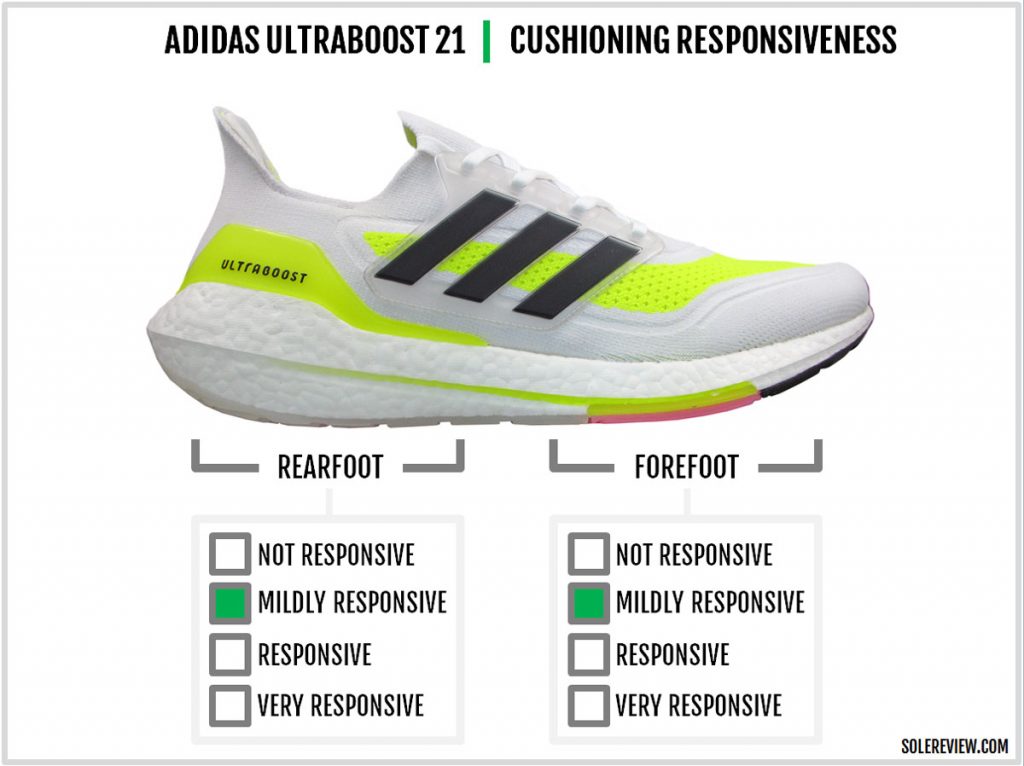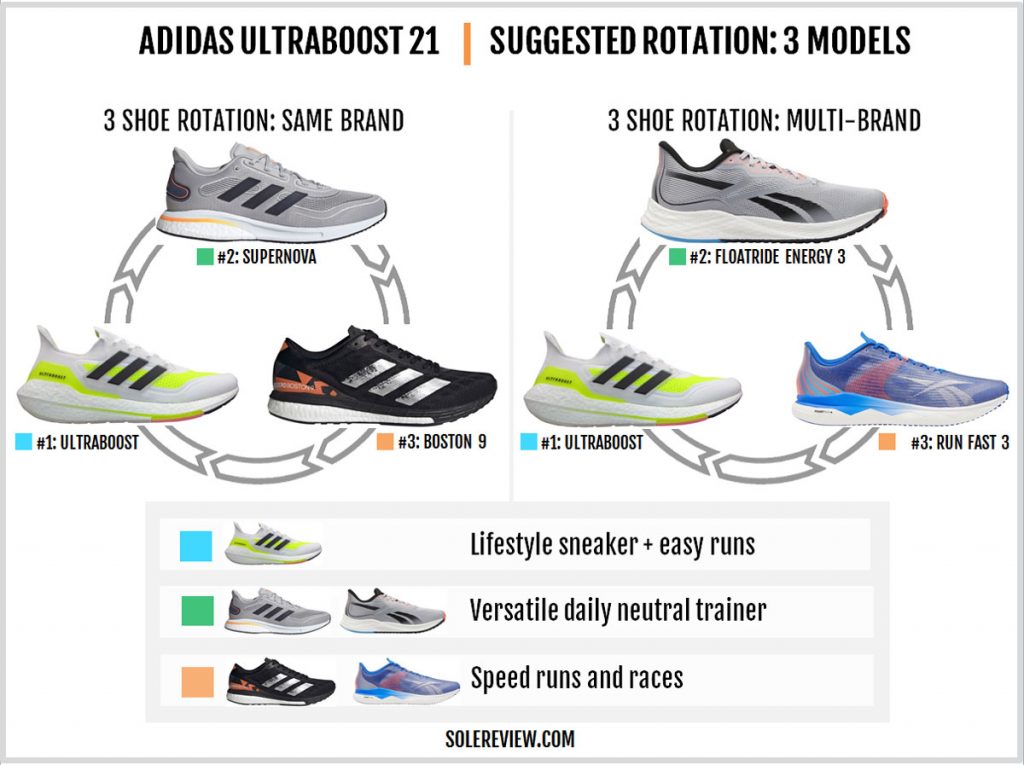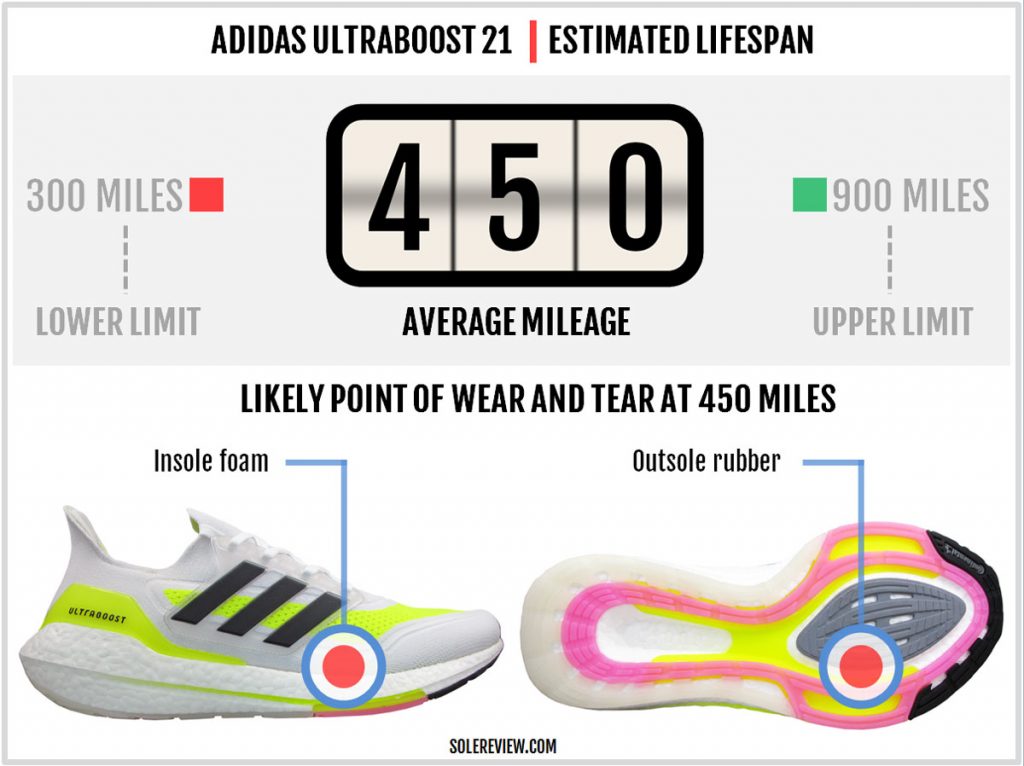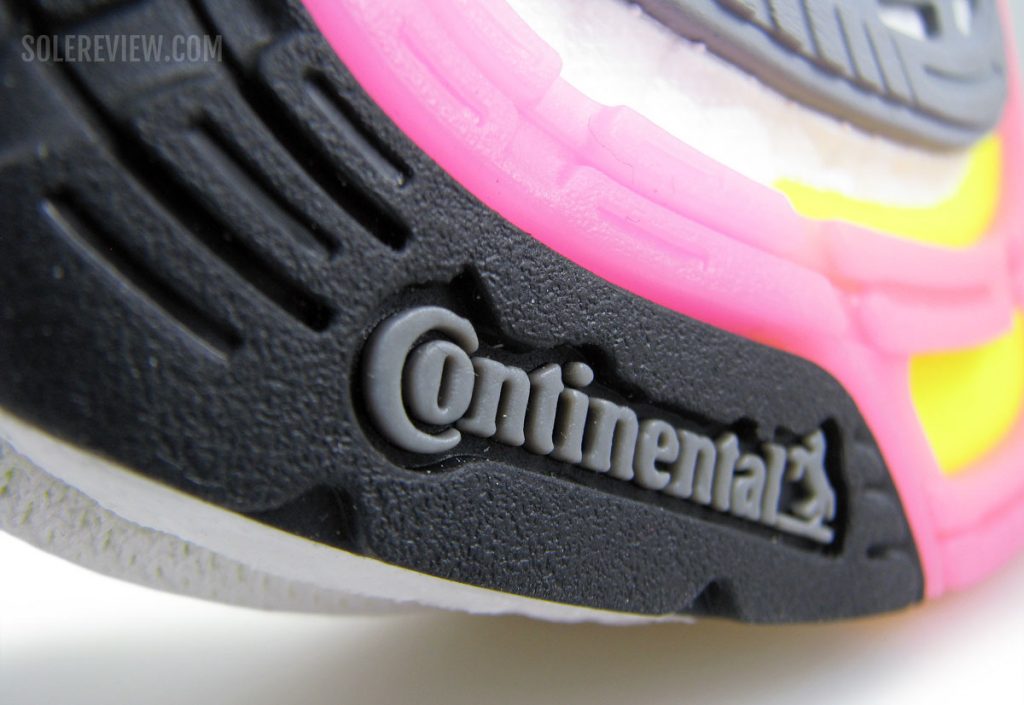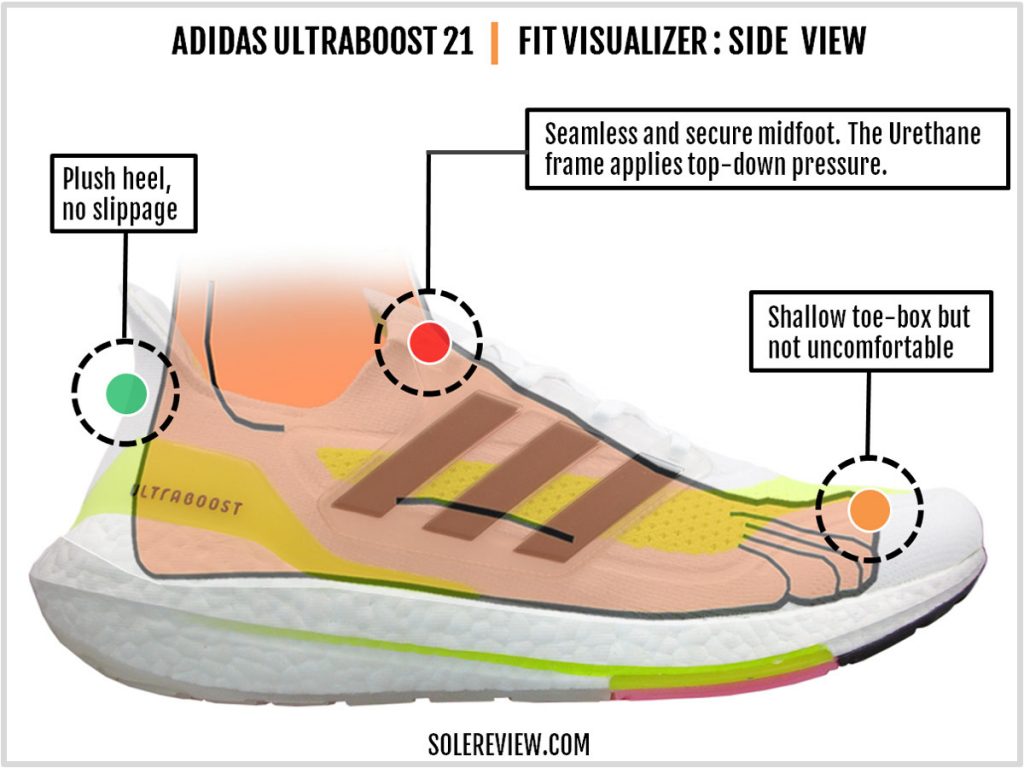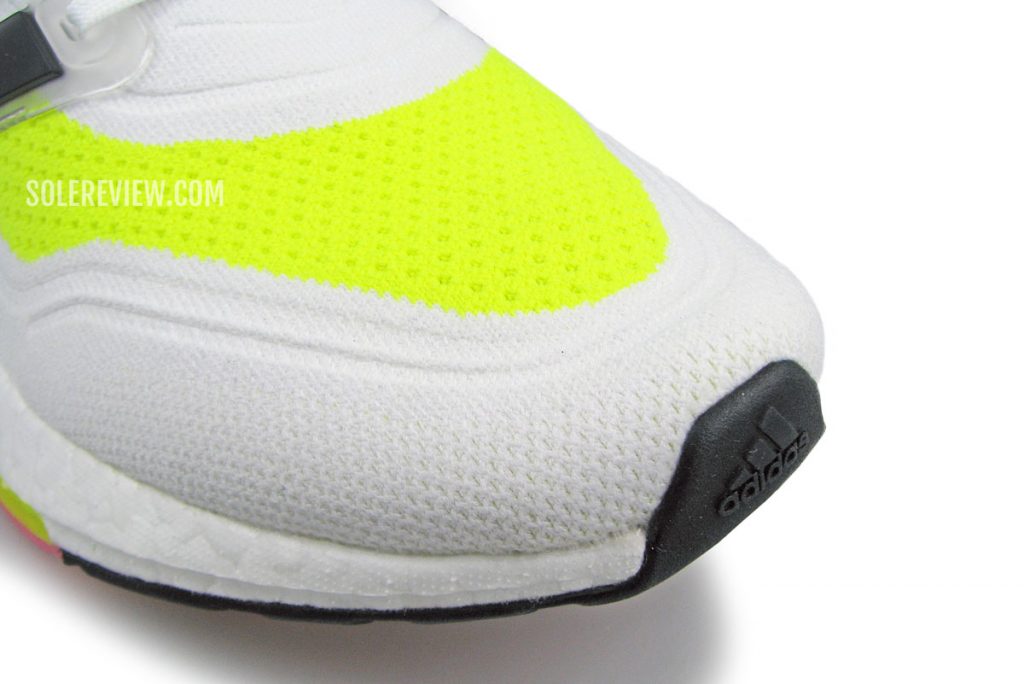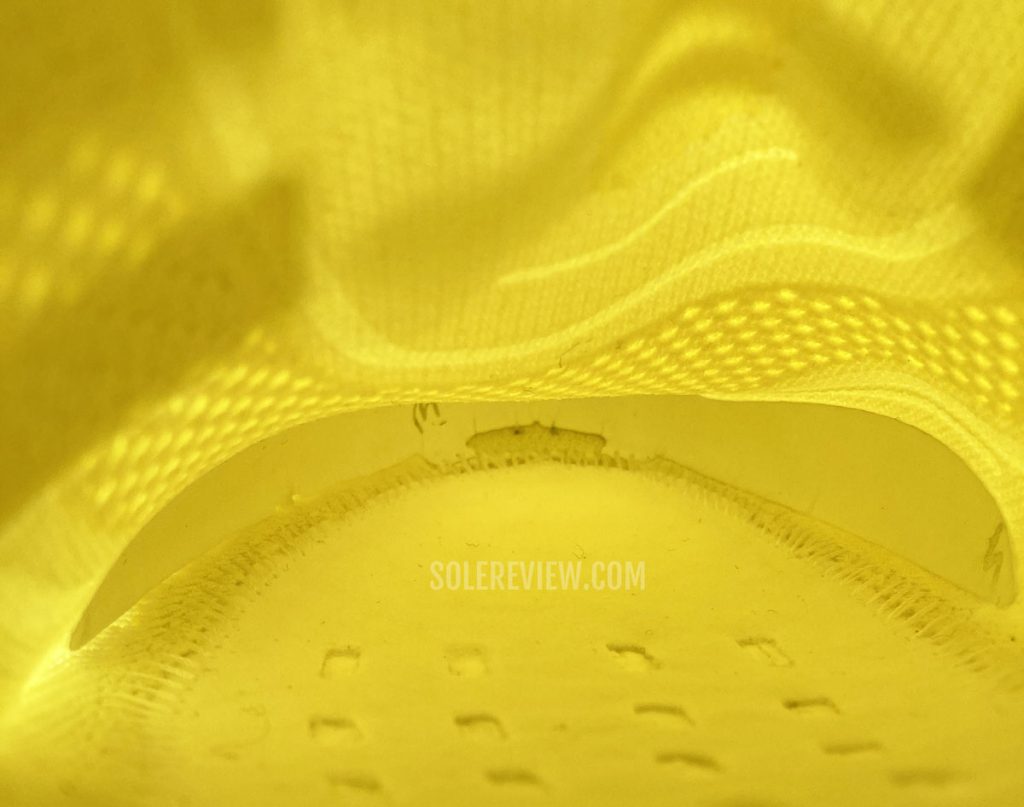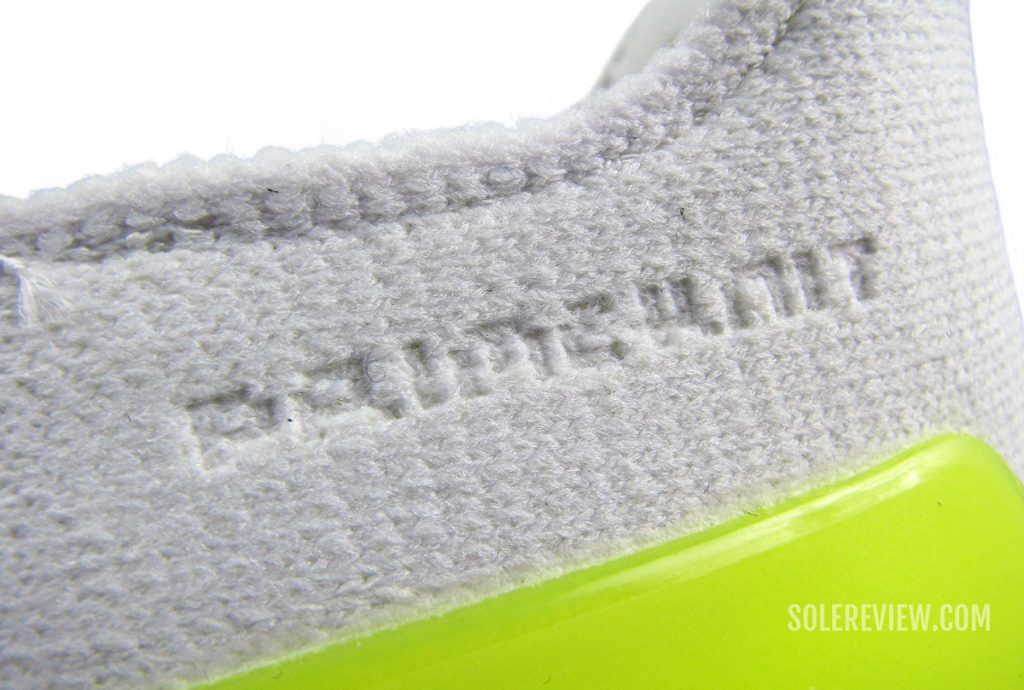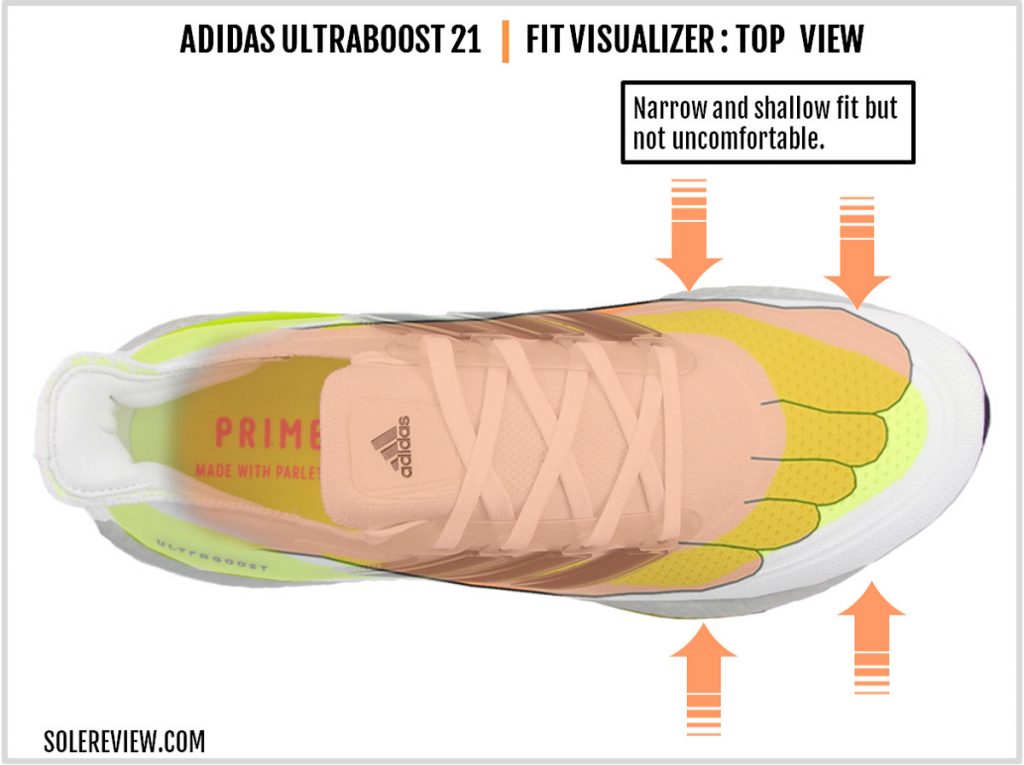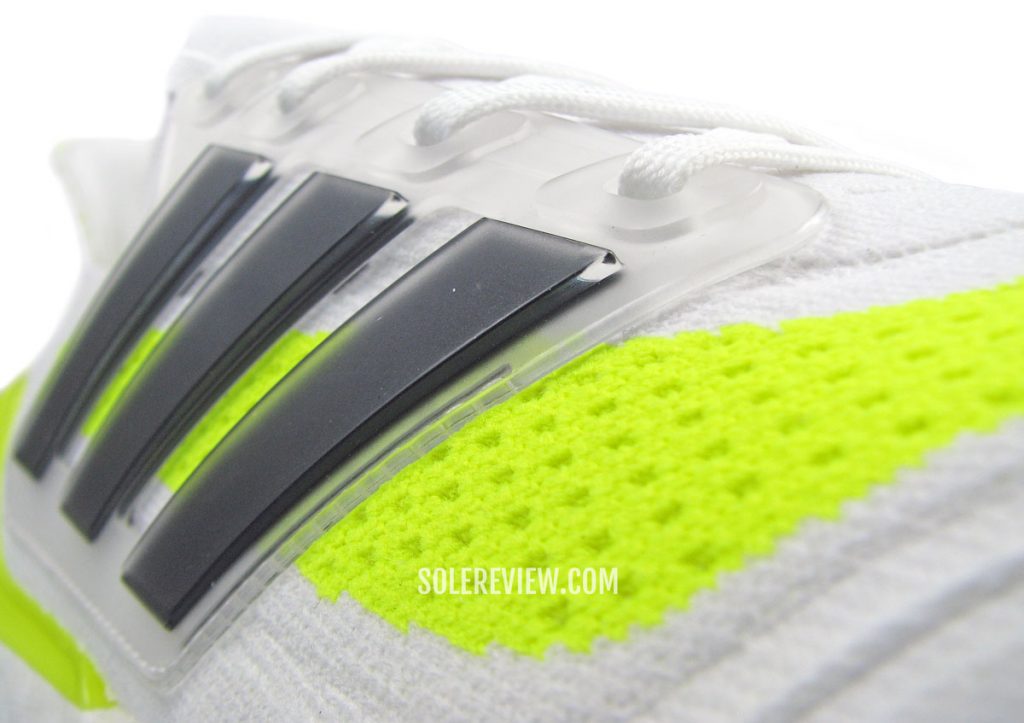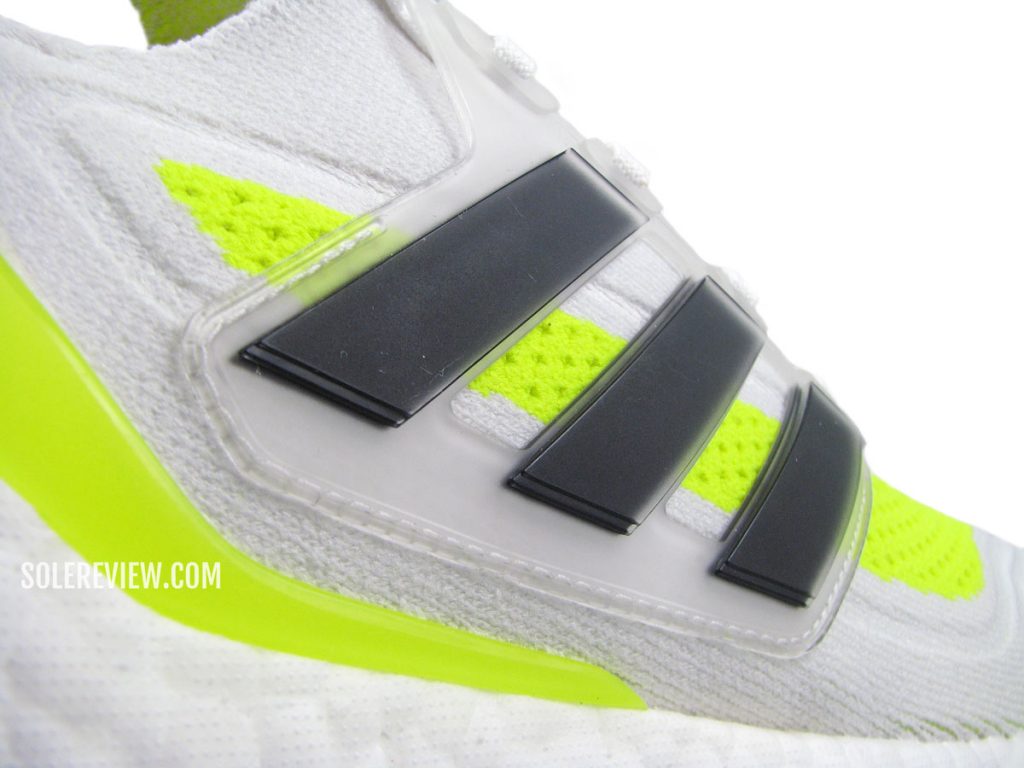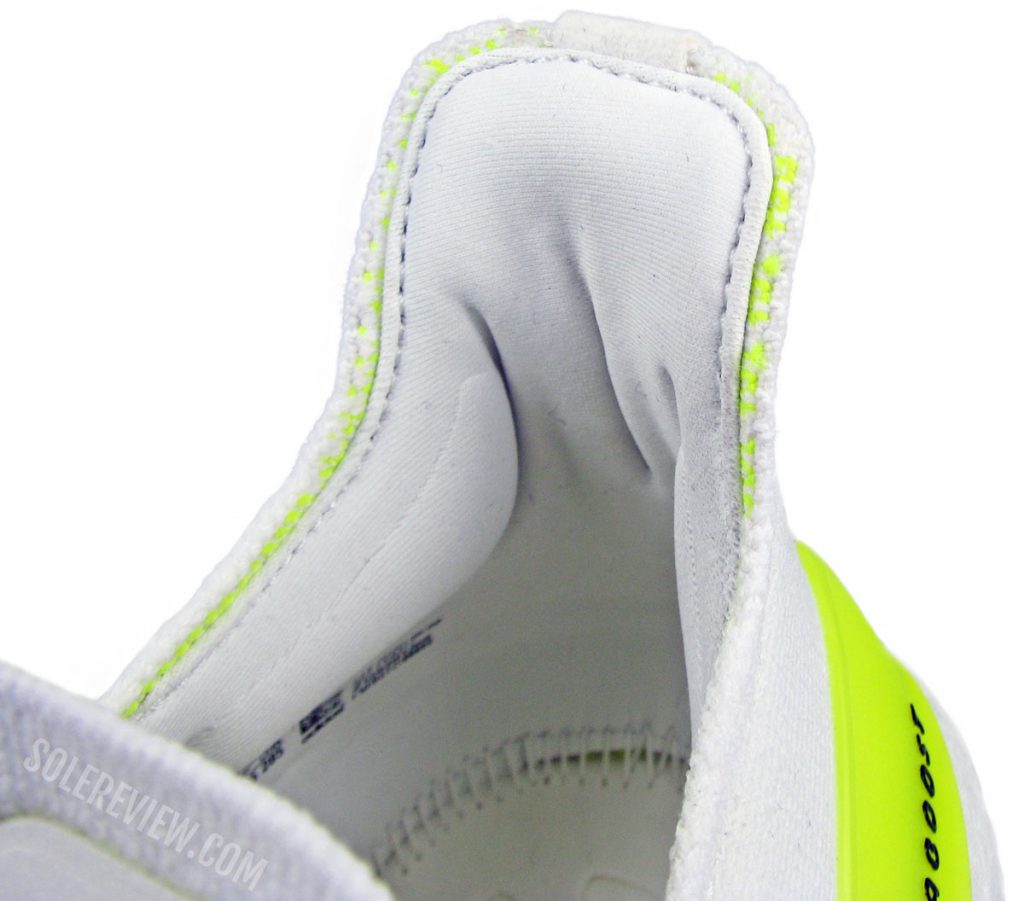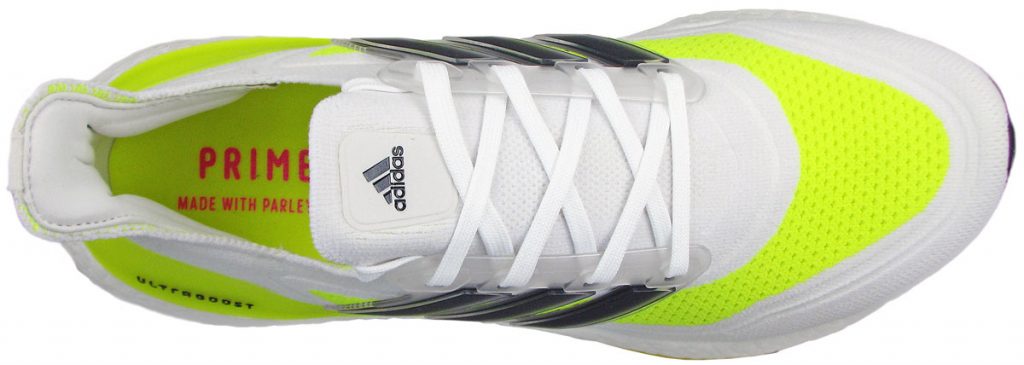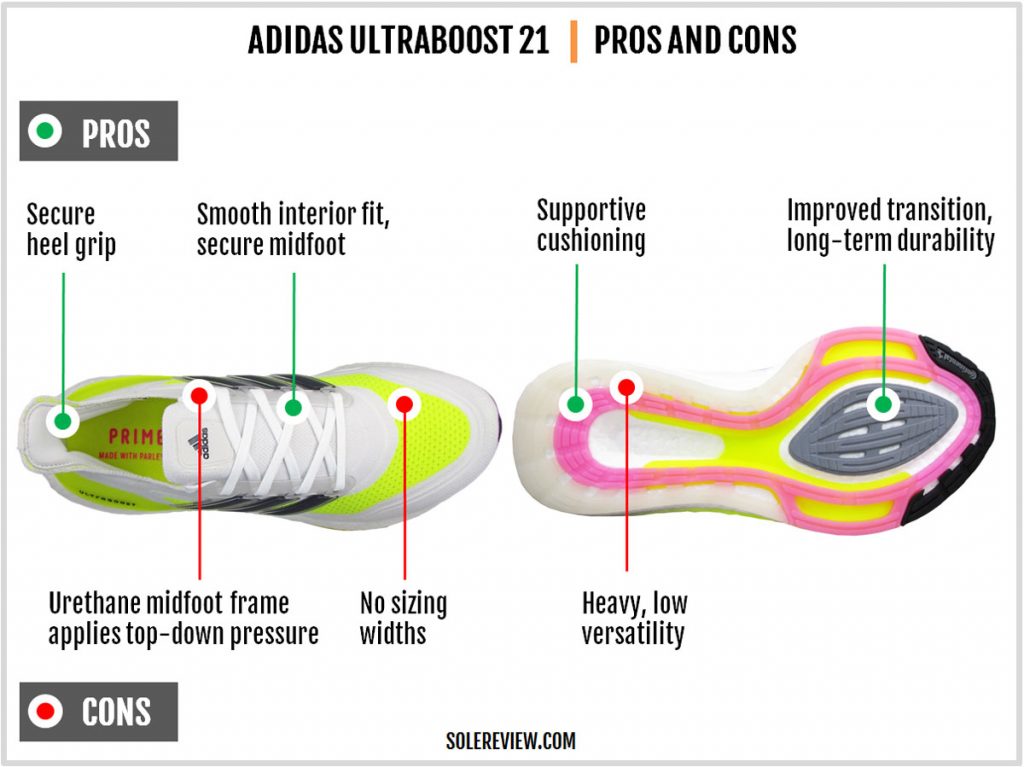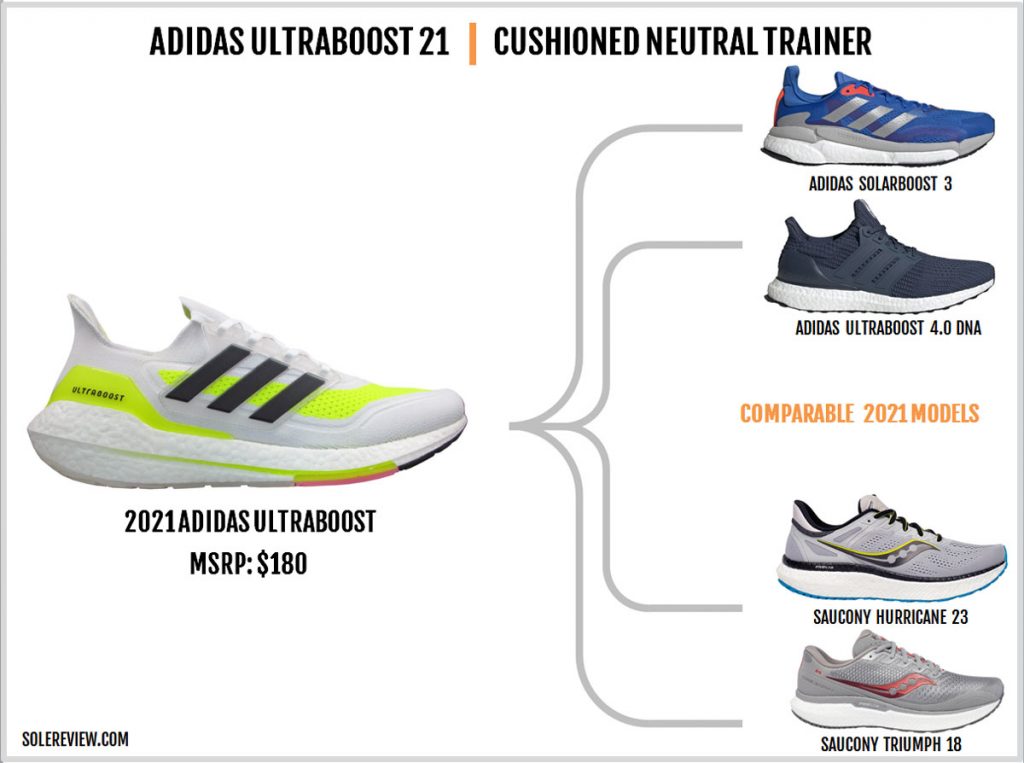The adidas Ultraboost 21 was purchased at full retail price for our review. This model has since been updated for 2022; our review of the Ultraboost 22 can be found here.
INTRODUCTION
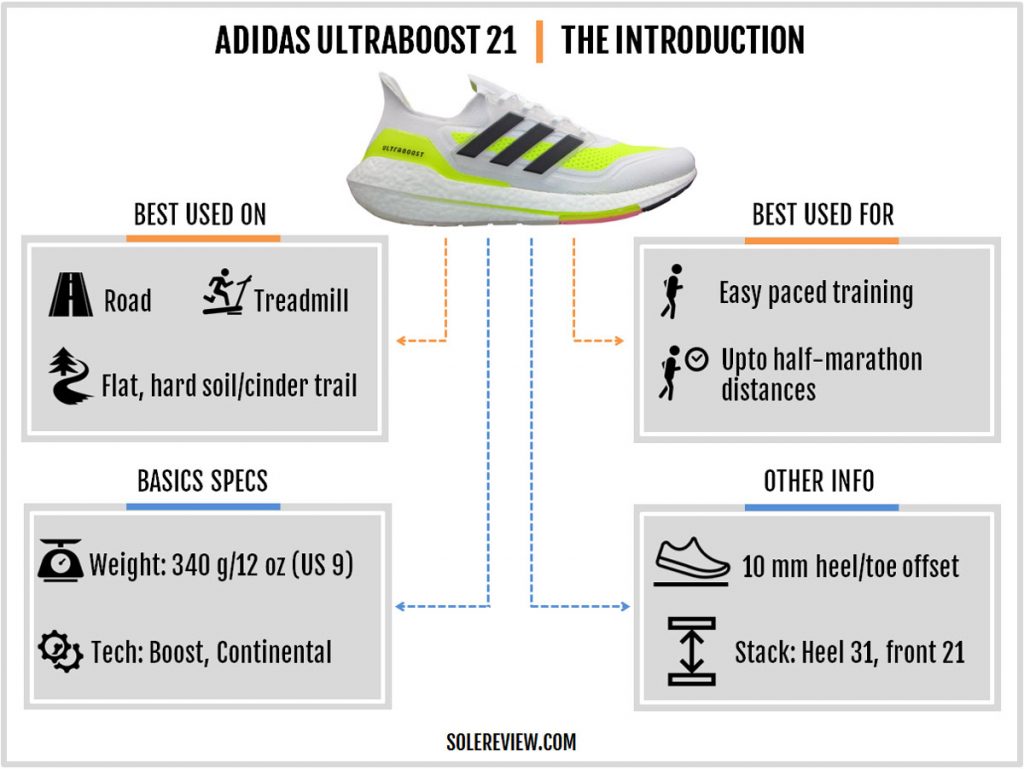
adidas needs to look itself in the mirror and ask – what kind of shoe does it want the Ultraboost to be?
There’s a reason why the Ultraboost franchise has cornered the high-end athleisure footwear market. It has never been a serious running shoe, but a cross-over silhouette that has always put all-day comfort and wearability first, and running performance second.
The Ultraboost 21 lacks the carefree character of the last few models. The midsole is (still) very cushioned, but the overall experience feels more ‘controlled’. In short, this new shoe discards some of its sneaker-like attributes and imbibes more running shoe traits.
We’re not sure whether this is a good turn of events for the Ultraboost.
It’s too clunky to be a versatile running shoe; and it’s even heavier than the ounce-lighter Ultraboost 20. On the other hand, if the Ultra-B’s entire value proposition is to be an uber-comfortable sneaker, then diluting the properties that made it so isn’t prudent thinking.
The Ultra-B’s $180 retail price hasn’t changed since its inception. It was fine when Boost foam was the only show in town, but its current price exists in a bubble when the rest of the world has moved on.
The changed reality includes newer midsole tech like PEBA, Carbon plates, and better uppers – whereas adidas’s Boost-and-Continental formula is a one-trick pony. To drive our point, we recently reviewed a PEBA midsoled shoe with a plate that retails at $160.
Or how about your bouncy royal highness, the Nike ZoomX Invincible Run that’s softer, an ounce lighter, and costs the same as the UB-21?
The transformed fit and ride character of the Ultraboost 21 is the result of substantial changes made to the 2021 model. The upper, midsole, and outsole receive a slew of updates that makes it a very different UltraBoost than the V19 and V20.
The new Ultra is visually striking; an effect that’s achieved by using an exaggerated midsole profile as well as aesthetic refinements on the upper. The changes go deeper than the surface, and lead to marked changes in the ride character.
At 340 grams or 12-ounces, the UB-21 is a heavier shoe, so the runs feel like a chore. However, the reconfigured outsole and Torsion plate makes the forefoot stiffer, so it does a better job at guiding the foot through the transitions.
The UB-21’s ride is firmer with a higher level of stability. Making that possible are the exaggerated midsole sidewalls that cup the foot around the heel, and a wide forefoot base that provides plenty of support during landings or toe-offs.
The plastic midfoot cage is back. Frankly, we don’t know why adidas even bothers. While it adds a nice cosmetic detail to the upper, the resulting stiffness over the instep isn’t worth it.
According to adidas, this shoe is partially manufactured using recycled Ocean plastic in partnership with Parley, so we’ll cut the brand some slack for all the plastic trims.
For casual-wear consumers, the Ultra-B is a comfortable sneaker that’s durable enough for everyday use. And when used as a running shoe, its performance-oriented qualities are relatively easier to access – but within limits.
THE ADIDAS ULTRABOOST 20 vs. ULTRABOOST 21
Based on paper specs alone, the UB-21 should be a softer shoe than the Ultraboost 20. After all, the 21’s midsole has more Boost (adidas says 6%), and the rear stack appears higher as well.
And yet, for reasons detailed in the introduction, the new UB is firmer and loses a lot of the easygoing bounciness. As to the why and how, we’ll cover that in the following section.
The upper is also chock-a-block with all things new. The knit mesh isn’t as stretchy or soft as the 20; the side panels made of thick urethane also add to the structured feel.
The UB 21 gains a lot of weight. Owing to the newly-acquired bells and whistles, it’s a full ounce heavier than the 20.
THE RIDE EXPERIENCE
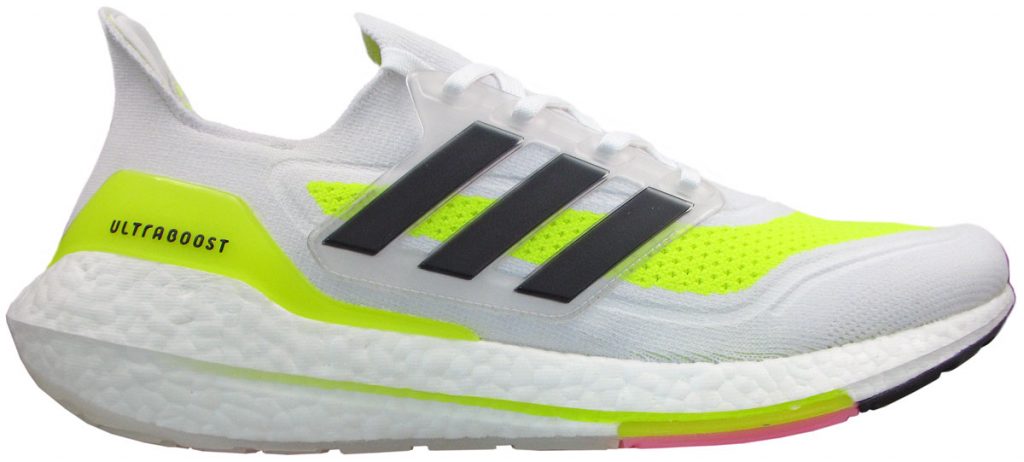
No, the midsole isn’t THAT thick. It’s an optical illusion that’s produced by the tall midsole edge.
The UltraBoost 21’s exterior profile can be deceiving. This is particularly true of the rearfoot where the midsole appears unusually thick, and a lot higher than the adidas-specified 30.5 mm stack.
The actual heel thickness is much lower, because the sidewalls have an exaggerated raise to form a cup around the foot. The actual midsole height is nearly half of what you see. On the other hand, the forefoot stack is WYSIWG.
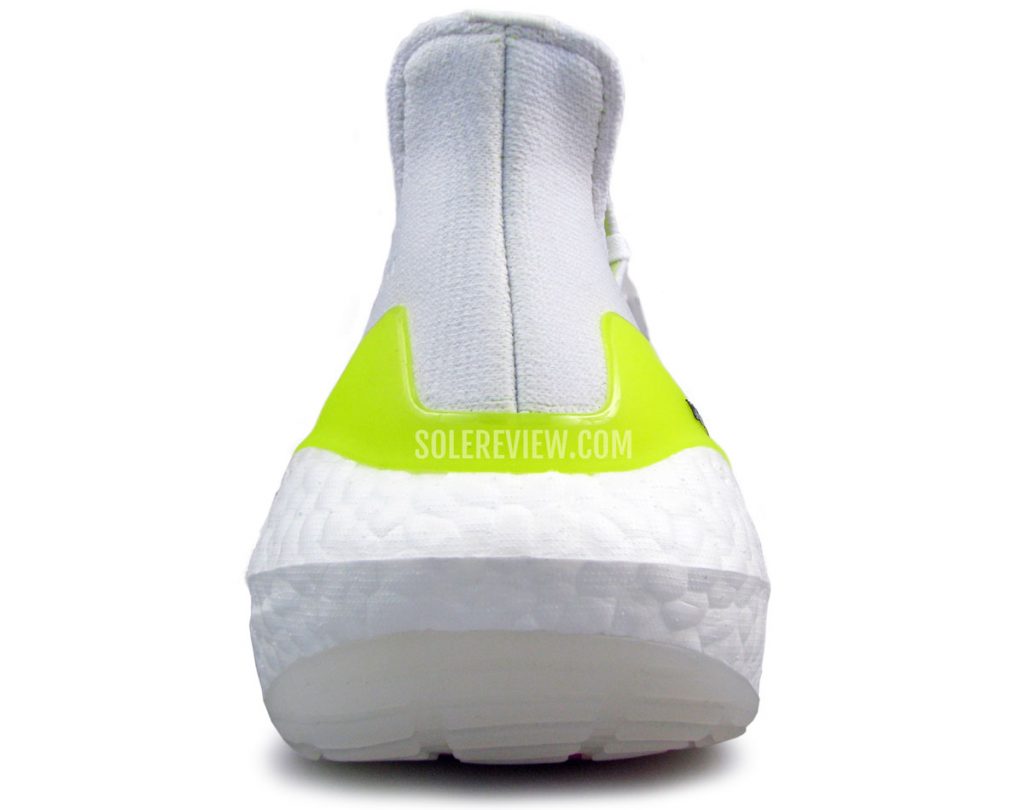
The rearfoot looks unusually thick, but the functional midsole height is nearly half of what you see.
So if you’re left wondering why the new Ultra doesn’t feel as soft as it looks, the perceived vs. actual midsole height is one of the reasons.
The second reason behind the firmer ride is the outsole. It’s still Continental, but assumes an entirely different geometry. The new Torsion shank is also a larger cog within the cushioning mechanism.
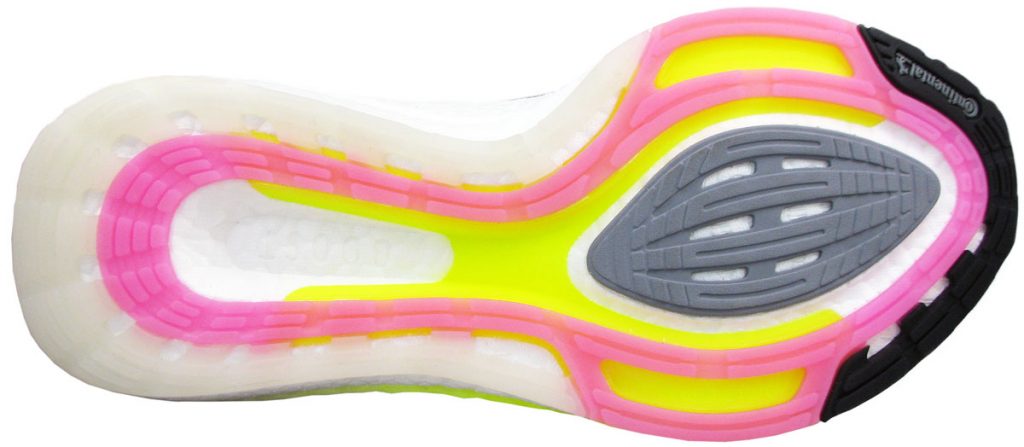
The redesigned geometry still relies on durable Continental rubber. However, the new layout and larger Torsion plate makes the ride firmer.
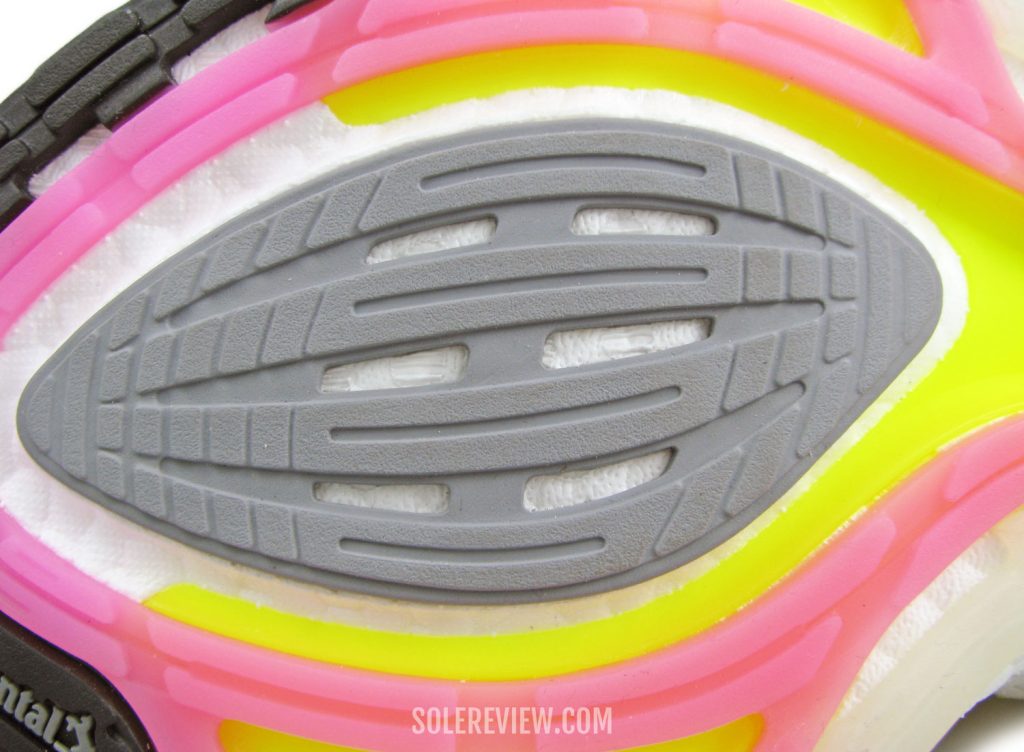
The forefoot center has a floating outsole piece – just like the adizero Boston and adios. The extended Torsion layer makes the transitions snappy.
The rubber is translucent, and somewhat similar to Saucony’s ‘Crystal rubber’ in appearance. The new geometry no longer has a lattice-like design with cut-outs exposing the Boost foam.
Though the rearfoot area has exposed Boost foam, the outsole section that’s just under the heel is fairly solid with low flexibility.
The heel midsole is wide – not only on the sides, but towards the back as well. The midsole has a fair bit of extension towards the rear. By now, most readers will realize what that means.
The UltraBoost 21 works best for rearfoot strikers than forefoot-landing runners. Well, the UB isn’t averse to forefoot striking, but it just happens to be a better fit for heel strikers.
One of the things we like about the new model is the higher level of stability. Even with the 30.5 mm stack, the heel is very stable – thanks to the cupping action of the raised midsole.
The outsole also gets a wide transition groove that centers the weight and makes the transitions smoother. Also, the Torsion shank plays a more important role in affecting the ride character.
This tuning fork-shaped component is larger than before. It spans from under the heel to the forefoot, so it’s one of the reasons why the presence of an under-heel groove fails to make the ride softer – as is often the outcome.
The stiff component reinforces the midsole and helps align the foot during the gait cycle. The Torsion plate spans nearly half the forefoot width and plays a critical role in how the transitions take place.
The forefoot is also the thinnest part (20.5 mm high) of the midsole, so the rigid layer produces a satisfying snap during the toe-off phase.
While the forefoot is sufficiently padded, there’s not a LOT of softness underneath. The Boost stack provides just enough cushioning for landings and transitions, but little else. This was true of the previous editions as well, so this isn’t new.
The outsole is cleverly designed, with the forefoot piece mounted in isolation over the midsole. This way, the outsole produces a ‘pistoning’ effect without being bound to the Torsion plate.
Unlike the Endorphin Speed, the Continental rubber outsole grips well – even after meeting a wet patch of road.
Of late, improved rubber formulations have made aggressive lug patterns an optional feature. For example, the completely flat outsole texture of the Asics Metaracer grips extremely well.
While the Continental rubber outsole isn’t as grippy as the Asics compound, we’ll be surprised if there are grip-related complaints. We certainly did not face any during our wear-testing process.
Like all the previous UltraBoost versions, the lasting below the removable insole has open windows to bring the foot closer to the Boost midsole.
The 2014 model was the first model to debut the windowed-lasting, and it’s been a part of the series ever since.
There’s a reason why adidas sells a wide variety of older UltraBoost models (like the DNA variant) alongside the 2021 model.
With the newly acquired change in its ride character, the latest Ultra-B lacks the familiar squish bounciness under the heel. Thus, it makes commercial sense to offer various flavors rather than switch everyone to the new – and vastly changed – product.
While the ride is still very cushioned, the increased stability and stiffer outsole dials down the bouncy squish, or what people like to describe as ‘energy return’. From the outside, the new Ultra should feel similar to a shoe with a high-volume Boost midsole – like the 2016 Ultraboost ST, for example.
Instead, what we get this year is a midsole that is firmer under the foot, with the loss of squishiness being more noticeable under the heel. This makes the UltraBoost 21 an ok running shoe for cruising at easy paces in the range of 6 min/km or 10 min/mile. We’d limit the distances to 12-15 miles due to the upper and overall bulk that is a bit of a struggle to carry around.
We only wish that the shoe wasn’t this heavy. In the golden age of PEBA-foam midsoles, a 12-ounce weight is a travesty. Runs in the UltraBoost feel like a slog; the excess weight adds a lot of unwanted inertia.
If the Ultraboost 21 isn’t the ideal daily trainer, then which shoe fits into that role? We recommend the adidas Supernova – a neutral trainer that combines an EVA frame with a softer Boost core. It’s nowhere as good as the Supernova Glide 7 or 8, but we have to make do with what we have.
But if you’re open to non-adidas options, the Reebok Floatride Energy 3 is an excellent – and versatile – option.
In our view, the Floatride Energy is a better shoe than the Supernova. The cushioned midsole is made of the same material as adidas Boost, except that it’s slightly firmer. Adidas owns the Reebok brand, by the way.
As a speed training or racing option, the adidas Boston 9 or adidas adios 5 work equally well. The Boston has a thicker stack than the adios – the latter has a thinner midsole. The Reebok Run Fast 3 is a lighter shoe than the adidas Boston 9 – thanks to its PEBA-based midsole. The Boston 10 is a different story, though – a review for another day.
IS THE ADIDAS ULTRABOOST 21 DURABLE?
The long-lasting adidas Ultraboost 21 also features on our curated list of durable shoes.
The translucent Continental rubber outsole will last hundreds of miles; the Boost midsole is a tried-and-tested cushioning material with high resistance to cushioning degradation. Only the removable EVA foam insole is susceptible to flattening.
The Primeknit upper is thick and stretchy, so it’s going to outlast the rest of the shoe.
THE UPPER DESIGN AND FIT
Some things will never change on the Ultraboost. Like the shallow toe-box and snug forefoot fit that’s been part of the series since its inception.
While in no way unpleasant, the stretchy Primeknit mesh pins the large toe down over the footbed. The shallowness also applies to the sides, so the entire forefoot is held in place securely by the upper. Larger widths are not optional.
The ventilation levels are average; since the upper snaps flush over the foot, there’s not a lot of circulation taking place. On a related note, our detailed guide on breathable running shoes delves into the science of ventilation.
Though the Ultraboost fits true to size, it feels a bit short due to the shallow toe area. Other than that, the interiors fit smoothly with a firm foothold.
Staying true to size will result in the best overall performance, since the foot needs to be positioned correctly to make the best of the midsole cushioning. Our experience states that a longer-than-necessary sizing results in a sub-optimal ride experience.
The plastic – or shall we say, Urethane – midfoot cage returns on the Ultraboost.
Its re-introduction appears to be a more style-driven decision than a functional one; because the softer rubber-like panels of the Ultraboost 20 worked just fine. Here, the part of the frame over the instep adds top-down pressure. It becomes progressively noticeable as the miles pile on.
The hot spot isn’t felt all over the frame – only on the top lateral side of the foot. That’s where the tongue flap is. Some padding may have helped, like how things were on the original Ultraboost.
We must mention that this is an issue only when running or brisk walking. It isn’t experienced when stationary or slow-walking.
On the bright side, the urethane frame helps the upper create plenty of under-arch support. The raised midsole sidewalls work together with the knit upper and urethane clip to support the foot.
The heel fit is excellent. The flared collar ‘lip’ is gentle on the Achilles, and the plastic clip + raised midsole cups the foot reassuringly.
The stretchy, sock-like entry and padded collar wrap softly around the foot; the ‘adidas’ text and logo over the tongue is the only piece of reflectivity on the upper.
It’s not the best location to place a high-visibility trim, but it’s better than having none.
PROS AND CONS
The midsole stability has vastly improved due to the added firmness, so that’s good – even though that comes at the cost of ride softness and bounciness. The larger Torsion shank makes the transitions more effective as well.
There’s still a generous amount of cushioning within the high-volume Boost midsole. That’s good for easy runs as well as casual everyday use. The overall build is very solid, so the shoe is going to last a long time – even though the upfront cost is high.
Do note that this is a 12-ounce shoe we’re writing about, so the versatility is limited.
With no widths available, the snug fit is not optional. Discounting that, the upper cinches the foot securely. The top-down lacing pressure is felt over the instep, and that gets in the way of long-distance comfort.
SHOES SIMILAR TO THE ADIDAS ULTRABOOST 21
If the unfamiliar ride firmness of the 21 is a deal-breaker, then other ‘DNA’ UltraBoost variants come to our rescue.
The ‘DNA’ suffix is used by the previous generation Ultraboost models. For example, there’s a DNA variant based on the original model, along with several others.
Also, there many colors of the Ultraboost 20 DNA models to choose from; their uppers have the ventilation-friendly ‘Clima Cool’ treatment.
Alternatively, the Saucony Triumph 18 and Hurricane 23 are better running shoes than the UltraB.
Like adidas Boost, both the Saucony models have a midsole made of expanded Polyurethane – except that the ride feels tighter and more performance-oriented. The Hurricane has a (more) supportive upper and midsole, and is the ‘stability’ version of the Triumph.
The adidas Solar Boost 3 has a relatively higher level of performance orientation, so that’s an option too – if you want to stick to a Boost midsole.
The Nike ZoomX Invincible Run is a slightly tangential alternative, because it’s a much lighter shoe with a high level of cushioning responsiveness and softness. So if road running is low on your list of priorities, then the Invincible proves to be a better (more comfortable and roomy) lifestyle sneaker.
There also exists a summer-RDY variant of the Ultra B-21. As the name suggests, it’s a better-ventilated variant of the regular model. That’s worth considering if breathability is important.
Do you own this shoe? Improve this review by sharing your insights – submit a review here.

